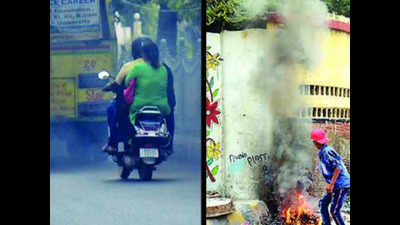- News
- City News
- patna News
- Patna air quality improves, but still remains ‘very poor’
Trending
This story is from November 5, 2019
Patna air quality improves, but still remains ‘very poor’
: The air quality in the state capital improved slightly on Monday but remained in ‘very poor’ category post-Diwali due to decreasing wind speed which drastically reduced the chances of dispersion of the pollutants in the atmosphere.

The environment experts in the city opined that air pollution would remain “very poor” or “severe” throughout this month due to climatic conditions
PATNA: The air quality in the state capital improved slightly on Monday but remained in ‘very poor’ category post-Diwali due to decreasing wind speed which drastically reduced the chances of dispersion of the pollutants in the atmosphere.
According to the Air Quality Index (AQI) released by the Central Pollution Control Board (CPCB), the PM 2.5 (fine particulate matter in the air with a diameter of less than 2.5 micrometres) level was recorded at 382 in Patna around 4pm on Monday.It has dropped from ‘severe’ (413) to ‘very poor’ in last 24 hours.
The air quality index of Muzaffarpur remained unchanged at 369 while Gaya also witnessed slight improvement in its air quality with 294 on Monday against 317 recorded on Sunday evening.
PM 2.5 was the primary pollutant at 382 microgram per cubic metre (ug/m3), followed by Nitrogen Dioxide (NO2) at 31 ug/m3, Sulfur Dioxide 83 ug/m3, Carbon Monoxide at 86 ug/m3 and ozone at 150 ug/m3 on Monday. As per the CPCB bulletin, the “very poor” conditions can cause respiratory illness on prolonged exposure.
The environment experts in the city opined that air pollution would remain “very poor” or “severe” throughout this month due to climatic conditions, including absence of western disturbances.
Pradhan Parth Sarthi, professor at Department of Environmental Science of Central University of South Bihar (CUSB), told this newspaper on Sunday that environmentalists have recently witnessed that western disturbances mainly originating in the Caspian Sea or Red Sea has reduced. “Due to reduction in western disturbances, we are not getting good amount of rain during winter season, resulting in high level of pollution,” he said.
“The present environment conditions of smog and haze can improve only with increase in wind velocity and rainfall. According to scientific methods, rain washes the pollutants in the environment while wind disperses the pollutants,” Sarthi said.
Sarthi, who is also the standing committee member of Bihar State Action Plan for Climate Change, said the aggravated air pollution in the city was due to vehicular emission or construction works in the open. “The same amount of vehicles moved in city and construction works are carried out throughout the year, but such smog conditions did not prevail in other seasons of the year,” he said.
Weather experts at Patna Meteorological Department said during winter onset, cooler air is trapped under the warmer air near the earth surface. “It forms a kind of atmospheric lid. Such situation leaves no space for pollutants to disperse in the atmosphere,” the weatherman said.
During summer, the level of pollutants decreases as the warmer air rises freely. It makes the boundary layer thicker and provides enough space for pollutants to disperse in the air.
According to the Air Quality Index (AQI) released by the Central Pollution Control Board (CPCB), the PM 2.5 (fine particulate matter in the air with a diameter of less than 2.5 micrometres) level was recorded at 382 in Patna around 4pm on Monday.It has dropped from ‘severe’ (413) to ‘very poor’ in last 24 hours.
The air quality index of Muzaffarpur remained unchanged at 369 while Gaya also witnessed slight improvement in its air quality with 294 on Monday against 317 recorded on Sunday evening.
PM 2.5 was the primary pollutant at 382 microgram per cubic metre (ug/m3), followed by Nitrogen Dioxide (NO2) at 31 ug/m3, Sulfur Dioxide 83 ug/m3, Carbon Monoxide at 86 ug/m3 and ozone at 150 ug/m3 on Monday. As per the CPCB bulletin, the “very poor” conditions can cause respiratory illness on prolonged exposure.
Among all pollutants, the most harmful ones are PM2.5 (which includes vehicles, garbage burning, diesel generators, factories emission among others) and NO2 (emitted from vehicles and factories). These pollutants can cause asthma, cancer, strokes and Alzheimer’s disease, experts feel.
The environment experts in the city opined that air pollution would remain “very poor” or “severe” throughout this month due to climatic conditions, including absence of western disturbances.
Pradhan Parth Sarthi, professor at Department of Environmental Science of Central University of South Bihar (CUSB), told this newspaper on Sunday that environmentalists have recently witnessed that western disturbances mainly originating in the Caspian Sea or Red Sea has reduced. “Due to reduction in western disturbances, we are not getting good amount of rain during winter season, resulting in high level of pollution,” he said.
“The present environment conditions of smog and haze can improve only with increase in wind velocity and rainfall. According to scientific methods, rain washes the pollutants in the environment while wind disperses the pollutants,” Sarthi said.
Sarthi, who is also the standing committee member of Bihar State Action Plan for Climate Change, said the aggravated air pollution in the city was due to vehicular emission or construction works in the open. “The same amount of vehicles moved in city and construction works are carried out throughout the year, but such smog conditions did not prevail in other seasons of the year,” he said.
Weather experts at Patna Meteorological Department said during winter onset, cooler air is trapped under the warmer air near the earth surface. “It forms a kind of atmospheric lid. Such situation leaves no space for pollutants to disperse in the atmosphere,” the weatherman said.
During summer, the level of pollutants decreases as the warmer air rises freely. It makes the boundary layer thicker and provides enough space for pollutants to disperse in the air.
End of Article
FOLLOW US ON SOCIAL MEDIA











